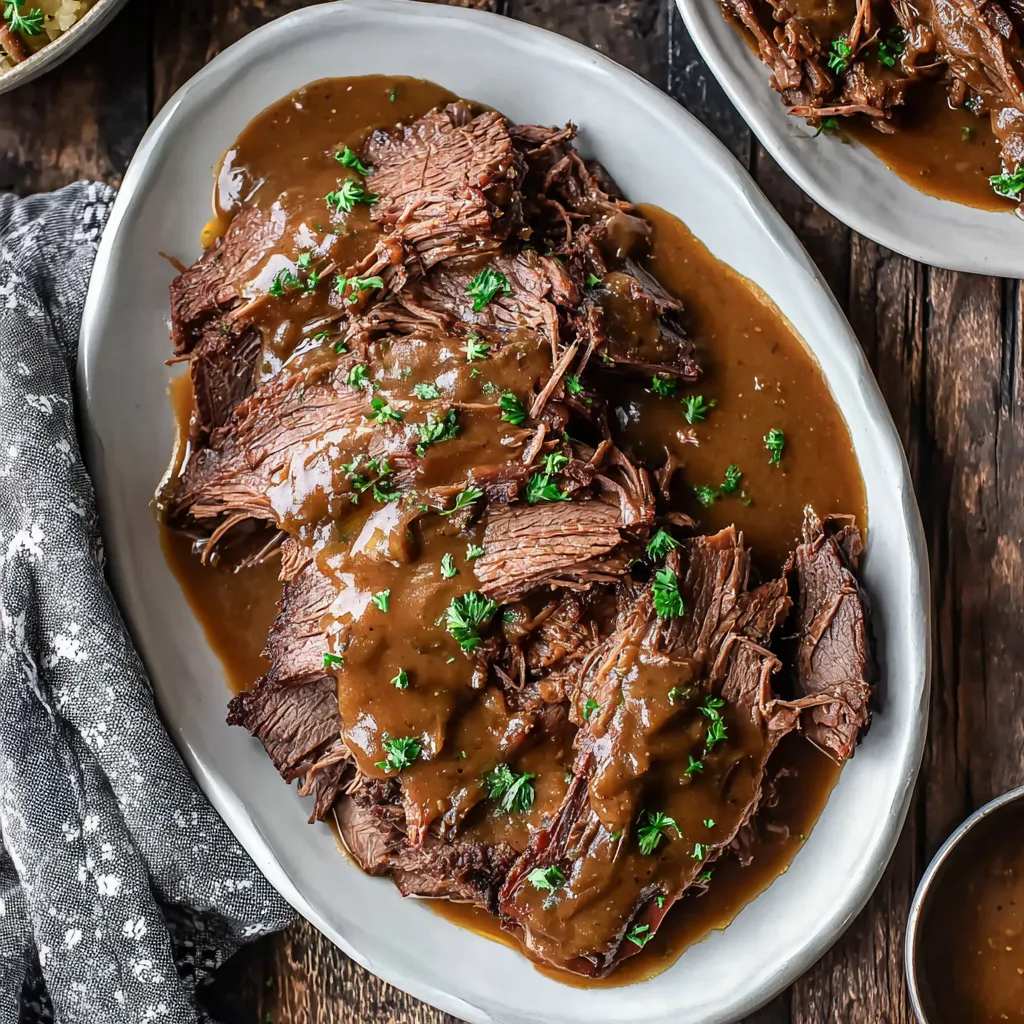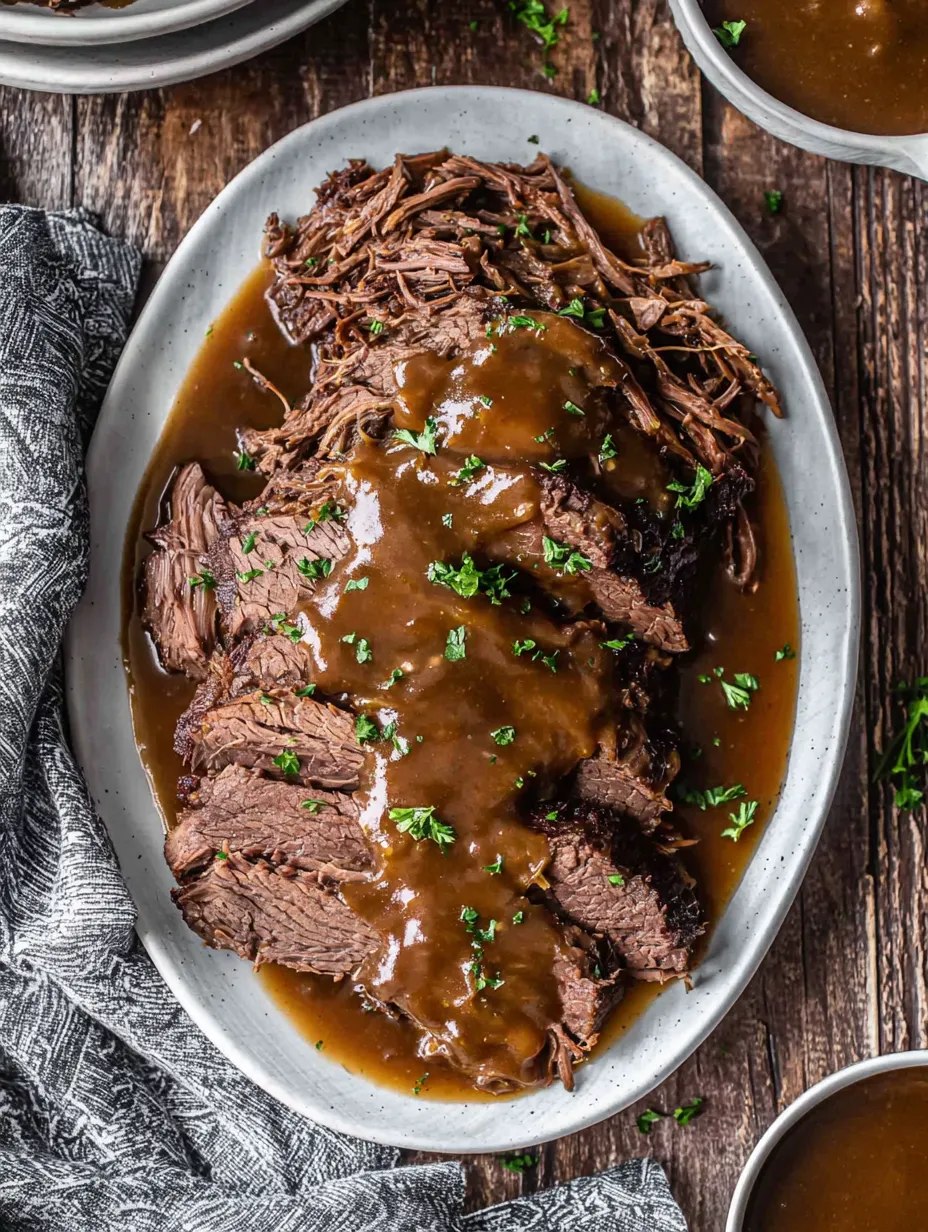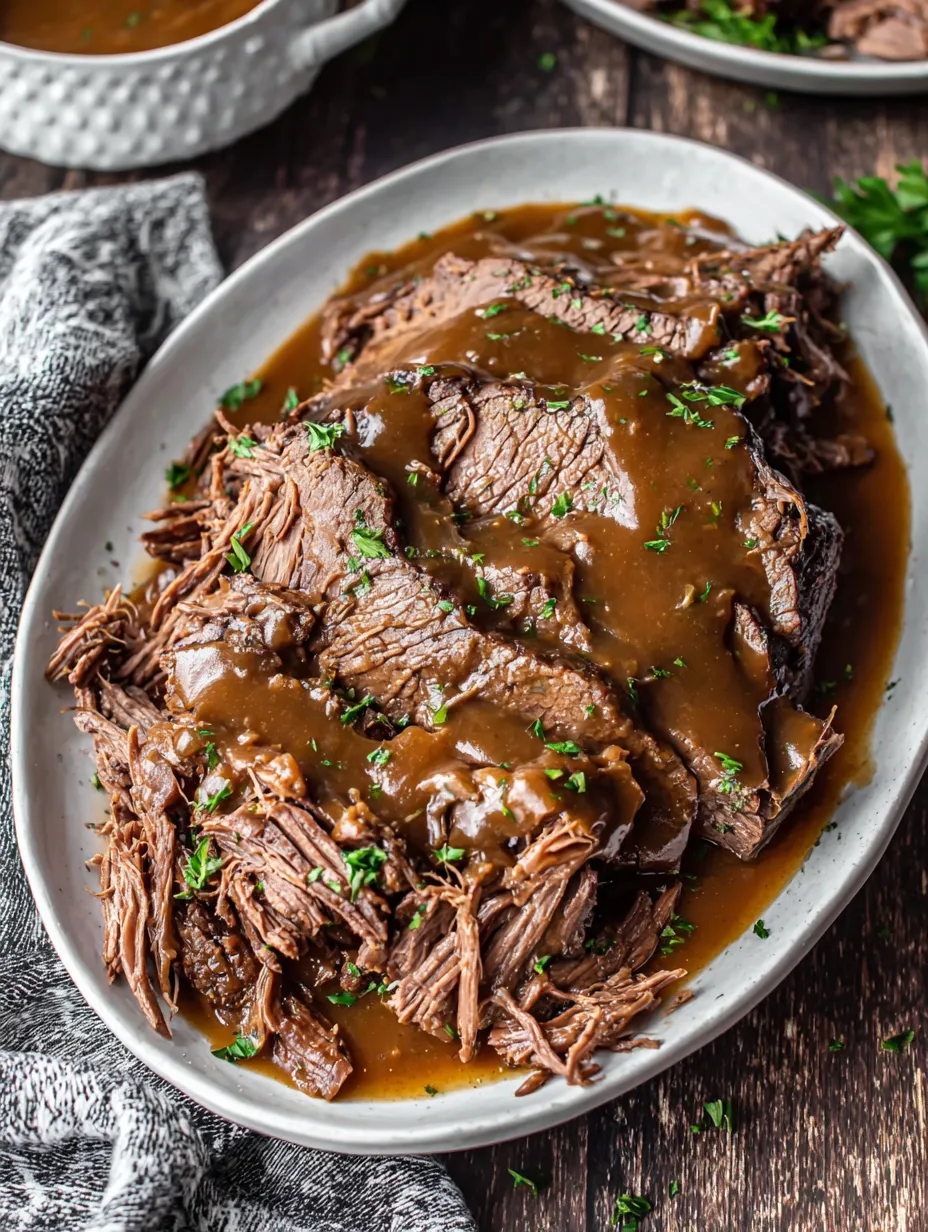 Highlight
Highlight
German sauerbraten always meant family gatherings to me. That melt-in-your-mouth meat and the sweet-tangy sauce just make it special. When it's chilly outside, nothing says home more than this meal.
I pulled off my first sauerbraten on a rainy Sunday. It turned a blah day into a mini holiday. Since then, this dish pops up every time we're together.
Ingredients
- Raisins (golden): add a pop of sweet, but you can totally skip them; go for those with an organic label
- Carrots: bring some sweetness into the marinade; thick, firm carrots work best
- Yellow onions: are the backbone of the marinade; grab them nice and fresh for better flavor
- Rosemary and thyme: go for fresh sprigs—they really kick up the taste
- Lorrel leaves: wrap up the marinade’s flavor in style
- Lauch (leek): slice it up so its taste spreads through the pot
- Cloves and black peppercorns: pile on flavor and a little cozy heat; give peppercorns a quick crack before tossing in
- Beef stew roast: something like shoulder or round, with a bit of marbling, is what you want for long slow cooking
- Garlic: gives a bit of sharp bite to balance things out; firm cloves are best
- Pepper and sea salt, sugar: balance all the sweet and sour vibes in the sauce
- Red wine: adds depth and color—pick one that’s dry and packs some punch
- Red wine vinegar: brings in the tang; it’s worth getting a good-quality bottle
- Juniper berries: for that signature fragrance—press them gently before you drop them in
- Gingersnaps: these thicken up the sauce and give it a subtle sweetness; top notch when you use real gingerbread
- Vegetable oil: needs to handle high heat so you get that nice brown crust
- Beef broth: brings out that rich meaty flavor—homemade is great if you have it
Simple Step-by-Step
- Finish with sauce:
- Lift out the meat, keep it warm. Pour the cooking liquid through a strainer for a smooth finish. Smash up gingersnaps and stir them in while the sauce simmers; they’ll make it rich and velvety. Season one last time with salt and pepper.
- Serve it up:
- Cut the beef into slices, ladle lots of sauce over the top and get it on the table while it’s steaming hot.
- Braise:
- Add the strained marinade to the veggies, crank up the stove to get it boiling. Drop in the beef, pop the lid on, and let everything cook low and slow until the meat comes apart with a fork.
- Sear the beef:
- Pour some oil into your biggest pot, heat it up really well. Brown the beef on each side, making sure it gets nicely crusted. Set the beef aside once it’s done sizzling.
- Sweat the veggies:
- Toss the veggies from the marinade into your pot. Let them get golden over medium heat; you're looking for those bits of caramelization for more flavor in your sauce.
- Pat meat dry and strain marinade:
- Take the beef out of the soaking liquid, dry it off with paper towels. Strain the marinade, set the veggies aside, hold on to the liquid for later.
- Mix up the marinade:
- Cut all your veggies into big chunks, stir them up with herbs, spices, salt, sugar, a pour of wine, splash of vinegar, broth and maybe raisins in a big bowl or pot. Dunk the beef until it’s covered, cover the whole thing, and stick it in the fridge for three days, flipping the meat now and then to soak up all that flavor.
 Highlight
Highlight
Good to know
Packed with protein, and braising keeps the meat extra juicy. Freezes great—doesn’t lose any flavor. Easy to toss in a slow cooker if you don't want to babysit the stove. Gingersnap cookies turn the sauce super creamy and flavorful. My kid's favorite job is smashing up those cookies, which always gets a laugh in our kitchen.
Leftover hacks
Sauerbraten stores without fuss in the fridge for a few days. Pop it in a good lidded dish and it'll stay tender even on day two or three. You can freeze single servings—just reheat gently and stir in a little broth or sauce if things look dry.
Try something new
If beef's not around, pork or game works, too. You can even use the marinade for chicken. No gingersnaps? Swap in honey cake or a hunk of rye bread instead.
 Highlight
Highlight
How to serve it
Traditionally you’ll spot potato dumplings and red cabbage on the table. But spätzle or bread dumplings do the trick, too. For fancy vibes, throw in glazed carrots and a scoop of lingonberry sauce.
Story and tradition
This old-school German dish originally used horsemeat! Back before fridges existed, that long soak in marinade was the trick to tenderize meat. These days, it’s saved for holidays and big get-togethers—and beef is the go-to.
Recipe FAQs
- → What's the best marinade time for pot roast?
Let it soak for at least three days, but five is even better. Flip the beef daily so every side gets plenty of flavor.
- → Which beef cuts work best for this dish?
Look for beef shoulder or round with some marbling. Slow cooking makes these cuts extra tender.
- → How does the gravy get that classic thickness?
Crumble ginger cookies into the pot and stir while simmering. That’s what gives it body and a lovely aroma.
- → What sides go well with this meal?
Usually it’s served with dumplings, noodles, or red cabbage, plus a generous spoonful of sauce.
- → Is it possible to make this in a slow cooker?
Sure, once it's marinated and seared, pop the meat in your slow cooker. Cook on low for eight to nine hours, no rush.
- → How should you store any leftovers?
Leftovers keep great in the fridge if you cover them up. By day two, the flavors get even better.
classic pot roast red wine
Juicy beef, deeply marinated, slow-braised, topped with a rich, sweet-tart sauce.
Ingredients
→ Marinade
→ Fleisch & Sauce
Steps
Zwiebeln, Karotten, Lauch und Knoblauch zusammen mit Thymian, Rosmarin, Lorbeer, Wacholderbeeren, Nelken, Pfefferkörnern, Meersalz, Zucker, Rotwein, Essig, Rinderbrühe und optional Sultaninen in einem großen Gefäß sorgfältig vermengen.
Rinderbraten vollständig in die Marinade legen, Gefäß abdecken und für mindestens drei, ideal fünf Tage im Kühlschrank durchziehen lassen. Das Fleisch täglich wenden, damit alle Seiten gleichmäßig aromatisiert werden.
Braten aus der Marinade nehmen, mit Küchenpapier behutsam trocken tupfen. Marinade durch ein Sieb gießen, das aromatisierte Gemüse und die Flüssigkeit auffangen und getrennt bereitstellen.
Pflanzenöl in einem großen Bräter kräftig erhitzen und das Fleisch von allen Seiten scharf anbraten, bis eine gleichmäßige Bräunung entstanden ist. Das Fleisch anschließend herausnehmen.
Das abgetropfte Marinadegemüse in den Bräter geben und bei mittlerer Temperatur 5–7 Minuten anrösten, bis es leicht gebräunt ist und intensive Röstaromen entwickelt.
Die aufgefangene Marinadenflüssigkeit angießen, aufkochen lassen, das Fleisch zurück in den Bräter legen und alles zugedeckt bei niedriger Hitze oder im vorgeheizten Ofen bei 160 °C Ober-/Unterhitze für 3–4 Stunden schmoren. Das Fleisch ist fertig, wenn es sich mit der Gabel leicht teilen lässt.
Das zarte Fleisch herausnehmen und zugedeckt warm halten. Den Bratensatz samt Flüssigkeit durch ein feines Sieb in einen Topf passieren. Das Gemüse entsorgen.
Zerbröselte Gewürzplätzchen schrittweise in die heiße Sauce rühren und alles unter ständigem Rühren sanft köcheln lassen, bis die Sauce die gewünschte sämige Konsistenz erreicht. Zum Schluss bei Bedarf mit Salz und Pfeffer abschmecken.
Den Braten in Scheiben schneiden, großzügig mit der aromatischen Sauce überziehen und umgehend heiß servieren.
Notes
- Für intensiven Geschmack das Fleisch mindestens drei Tage marinieren, fünf Tage bringen besonders ausbalancierte Aromen.
- Gut marmorierte Rinderbug- oder Hüftstücke eignen sich optimal, da sie beim Schmoren extrem zart werden.
- Zerbröselte Gewürzkekse sorgen für eine samtige Bindung und runden die Sauce durch milde Süße elegant ab.
- Zubereitung kann auch im Slow Cooker erfolgen; dafür nach dem Anbraten auf niedriger Stufe 8–9 Stunden schmoren lassen.
- Beilagenempfehlung: Kartoffelklöße, Spätzle oder Rotkohl harmonieren traditionell und heben den Genuss.
Required Equipment
- Großer Bräter oder ofenfester Schmortopf
- Feines Sieb
- Kochlöffel
- Schneidebrett
- Scharfes Messer
Allergen Information
Double-check every ingredient for potential allergens and consult a healthcare professional if unsure.
- Enthält Gluten, insbesondere durch die verwendeten Gewürzplätzchen.
Nutritional Information (Per Serving)
This data is for informational purposes only and doesn’t replace medical advice.
- Calories: 480
- Fat: 24 g
- Carbs: 20 g
- Protein: 38 g
